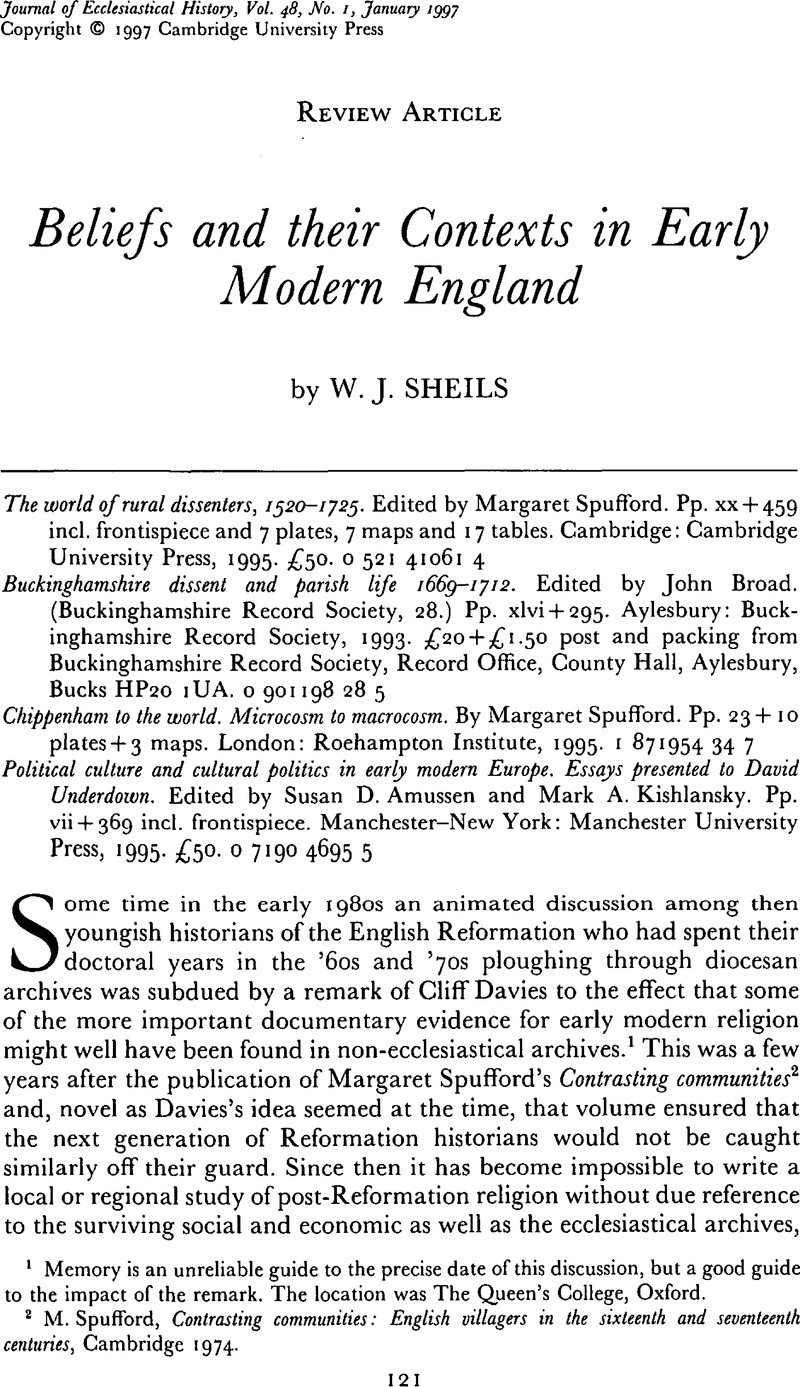Article contents
Beliefs and their Contexts in Early Modern England
Published online by Cambridge University Press: 06 February 2009
Abstract

- Type
- Review Article
- Information
- Copyright
- Copyright © Cambridge University Press 1997
References
1 Memory is an unreliable guide to the precise date of this discussion, but a good guide to the impact of the remark. The location was The Queen's College, Oxford.
2 Spufford, M., Contrasting communities: English villagers in the sixteenth and seventeenth centuries, Cambridge 1974CrossRefGoogle Scholar.
3 Most of these are Cambridge PhD dissertations, but see especially Marsh, C., The Family of Love in England 1550–1630, Cambridge 1994Google Scholar; Carlson, E., Marriage and the English Reformation, Oxford, 1994Google Scholar; and for printed ephemera, Watt, Tessa, Cheap print and popular piety, 1550–1640, Cambridge 1991Google Scholar.
4 Rural dissenters, 5.
5 Plumb, Derek, ‘The social and economic spread of rural Lollardy: a reappraisal’, in Sheils, W. J. and Wood, Diana (eds), Voluntary religion (Studies in Church History xxiii, 1986), 111–30Google Scholar.
6 Davies, R. G., ‘Lollardy and locality’, Transactions of the Royal Historical Society 6th ser. i (1991), 191–212CrossRefGoogle Scholar.
7 Rural dissenters, 163.
8 Ibid. 14, where the gathered church has lost its question mark.
9 Ibid. 392.
10 Watts, M., The dissenters: from the Reformation to the French Revolution, Oxford 1978, 382–93Google Scholar.
11 Vann, R., The social development of English Quakerism, 1655–1755, London 1969CrossRefGoogle Scholar.
12 This could lend further weight to the point made earlier that sect-type analysis is not the most useful approach to Lollardy. The absence of this particular form of ‘public’ ordinance was also true, of course, for Quakers. To what extent this differentiated their experience from that of other dissenting groups is unclear.
13 Collinson, P., ‘The English conventicle’, in Sheils, and Wood, , Voluntary religion, 223–59Google Scholar.
14 Everitt, A., ‘Nonconformity in country parishes’, in Thirsk, J. (ed.), Land, Church and people (Agricultural History Society, 1970), 178–99Google Scholar.
15 Rural dissenters, 331.
16 Ibid. 304, 308, 393.
17 Sheils, W. J., The Puritans in the diocese of Peterborough 1558–1610 (Northamptonshire Record Society xxx, 1979), 67–72, 131–42Google Scholar; Richardson, R. C., Puritanism in north-west England: a regional study of the diocese of Chester to 1642, Manchester 1972, 22Google Scholar.
18 Rural dissenters, 403–4.
19 Ibid. 61, 386, 401.
20 Ibid. 235–72; I. M. Green, ‘“For Children in Yeeres and Children in Under-standing”: the emergence of the English catechism under Elizabeth and the early Stuarts’, this JOURNAL xxxvii (1986), 397–425.
21 Broad, , Dissent and parish life, 11–12Google Scholar.
22 Ibid. 39–40.
23 Ibid. 249–50.
24 Ibid. 99.
25 Milton, A., Catholic and reformed: the Roman and Protestant Churches in English Protestant thought, 1660–1640, Cambridge 1995CrossRefGoogle Scholar.
26 See the debate between Underdown, and Morrill, in Journal of British Studies xxvi (1987), 451–80Google Scholar, following publication of Underdown's, Revel, riot and rebellion: popular politics and culture in England 1603–1660, Oxford 1985Google Scholar.
27 Rural dissenters, 232.
- 1
- Cited by




